The Battle of Jutland
The Battle of Jutland was fought off Denmark's North Sea coast, involving around 250 ships and 100,000 men of the British and German Navies. It was the only major naval engagement between battleships in World War One, with victory claimed on both sides.
 Tactically the battle of May 31st, 1916, into the early hours of June 1st, is now considered a draw, but for Britain it was a strategic victory as it meant that the German surface naval threat had to a large extent been neutralised and the Britain's supply lifelines were more safeguarded, other than from submarine attacks which would eventually bring the United States into the war in 1917.
Tactically the battle of May 31st, 1916, into the early hours of June 1st, is now considered a draw, but for Britain it was a strategic victory as it meant that the German surface naval threat had to a large extent been neutralised and the Britain's supply lifelines were more safeguarded, other than from submarine attacks which would eventually bring the United States into the war in 1917.
Jutland was a battle that had been anticipated and the British were forewarned thanks to codebreakers. The German Navy was being built up for about a decade before the outbreak of war, but had avoided direct confrontation with the British Navy until it was decided to attempt to break out and lure the British High Fleet into ambush in small sections.
Following an initial skirmish, British Admiral Sir David Beatty withdrew, drawing the German fleet into the path of the main British fleet commanded by Admiral Jellicoe. Fourteen British and 11 German ships were sunk before the German fleet managed under cover of poor visibility and growing darkness to return to port.
The battle cost the lives of over 6,000 British sailors, among them two 16-year-old boys from Luton. It also claimed the life of 16-year-old Essex lad Jack Cornwell, who was awarded a posthumous VC for gallantry in the battle, and who would be commemorated in Luton on the Comrades of the Great War float in the Peace Day parade that preceded the riots in which the Town Hall was burnt down.
First news in Luton of the battle was carried in the Saturday Telegraph on June 3rd, 1916. It contained an Admiralty report that three British battle cruisers, two cruisers and eight destroyers had been sunk with one cruiser abandoned after being badly damaged. It was reported that 11 German ships had been destroyed/sunk with several other ships damaged or disabled.
Sixteen survivors had been taken to Holland by a trawler, and a Danish steamer had arrived at Hull with seven men, two badly injured, one of whom later died. Danish fishermen reported hundreds of British and German bodies floating on the surface of the sea.
By the time the Luton News was published on the following Thursday, details of those known to have drowned, were missing or were safe began to appear in print. It said: "Locally, we record some individual cases where Luton men are to be chronicled amongst those who bravely fought and died. Doubtless there are others, about which we should be grateful for information so that their gallant deeds may receive like recognition."
The following from Luton or with Luton connections were mentioned in the Luton News and Saturday Telegraph over the following two weeks:
LOST IN ACTION
Signal Boy J/34280 Frederick George Darby, aged 16, killed or died as a result of enemy action while serving on HMS Black Prince (sunk). Son of Mrs Mary Ann Darby, of 7 Princess Street, Luton. (Chatham Naval Memorial).
Signal Boy J/34158 Arthur Olney, aged 16, killed or died as a result of enemy action while serving on HMS Queen Mary (sunk). Son of Mrs Susan Olney, of 32 Hibbert Street, Luton. (Portsmouth Naval Memorial).
Gunner RMA/12399 Edmund Charles Dexter, Royal Marine Artillery, aged 26, killed or died as a result of enemy action while serving on HMS Invincible (sunk). Son of Edmund E. Dexter, of 5 Warwick Road, Luton, he was married with a wife and three-month old baby living in Portsmouth. (Portsmouth Naval Memorial).
Leading Stoker K/22633 Frederick Neville, aged 29, killed or died as a result of enemy action while serving on HMS Queen Mary (sunk). The native of Luton and former pupil of Dunstable Road School had been in the Navy for five years before returning to civilian life for a year, working at Luton Gas Works, and then returning to the Navy four years before the Battle of Jutland. (Portsmouth Naval Memorial).
Engineer-Lieut John McLennan Hine, aged 44, killed in action on HMS Invincible (sunk). He was married with four young children and his family had lived in Rothesay Road, Luton, prior to 1910. (Portsmouth Naval Memorial).
Sub-Lieut Frank Alan Single, aged 20, killed or died as a result of enemy action while serving on HMS Warspite (damaged but returned to port). He was the nephew of Luton hat manufacturer Mr J. C. Kershaw. (Queensferry Cemetery, West Lothian).
MISSING, BELIEVED KILLED
Seaman Henry Shedrick Joseph Hill, 19, son of Mr and Mrs Henry Hill, of 94 Cobden Street, Luton, was reported lost in the Battle of Jutland while serving on HMS Turbulent (sunk). Naval records reveal, however, that he was wounded and taken as a prisoner of war before being repatriated in 1918 and invalided from the service. He married Gertrude Currie in Luton in 1919.
SURVIVORS
Seaman Victor Whittemore, at first reported lost while serving on HMS Queen Mary, confirmed in a letter to his mother at 42 King's Road, Luton, that he had survived the sinking.
First Class Boy Francis James Allen, aged 17, serving as a gun sighter on HMS Warspite, confirmed in a letter to parents Mr and Mrs Samuel Allen, of 59 Warwick Road, Luton, that he was safe. He had joined Warspite at Easter 1915 after training at Shotley Barracks. The former regular attender at All Saints Church, Luton, was home on leave in November 1915 and hoped to be home again shortly.
Seaman Thomas Fensome, youngest son of Mr and Mrs George Fensome, of 93 Hitchin Road, Luton, had served on HMS Warspite, which was damaged in the battle but was credited by its crew with having sent two enemy cruisers and several destroyers to the bottom. The former Diamond Foundry and Hayward Tyler employee was in the ship's magazine below decks during the battle.
Chief Engineer Artificer Frank Holt was another survivor from the Warspite. The former Queen Square and Waller Street schools pupil had been in the Navy for 15 or 16 years and was returning from Australia when war broke out. He was married and a father living in Devonport. His own father, Francis Holt, lived at 53 Adelaide Street, Luton.
[Illustration: Wikimedia]
Able Seaman Henry Shedrick Joseph Hill
Title (Mr/ Mrs/ Capt/ Rev etc):
First name(s):
Surname only:
Seaman Henry Shedrick Joseph Hill, 19, son of Henry and Mary Ann Hill, of 94 Cobden Street, Luton, was reported lost in the Battle of Jutland while serving on HMS Turbulent (sunk).
Naval records reveal, however, that he was wounded and taken as a prisoner of war before being repatriated in 1918 and invalided from the service. He married Gertrude Currie in Luton in 1919.
Seaman Hill joined the Navy in November 1914. He had served on various vessels, and six weeks before the Battle of Jutland he had been home on 21 days leave. He was allocated to the Tubulent on his return to his depot.
Prior to enlistment Seaman Hill was employed as a moulder at the Brown and Green foundry in Luton.
On July 8th, 1916, the Beds & Herts Saturday Telegraph reported the news that Seaman Hill was probably a prisoner of war. His parents were informed by the Accountant-General of the Navy that 14 men from the Turbulent were unofficially reported to have been received by the German naval forces and detained as prisoners of war in Germany. But it could be a considerable time before the German Government released names.
Next came an unofficial report received via the British Red Cross that Seaman Hill had been rescued by the enemy and was a prisoner of war at Dulmer, Westphalia, Germany.
Finally, a report received from the Prussian Ministry of War through the American Ambassador in Berlin confirmed that he was a prisoner of war and was suffering internal injuries. Nothing had been heard by the parents directly from their son at that stage.
Service or Civilian?:
Service Number:
Regiment:
Employer:
War time / or Pre War occupation:
Place of Birth:
Place of Death:
Grave Location:
World War I Address:
Individual Location:
Classifications:
Images:

Year of Birth:
Month of Birth:
Day of Birth:
Year of Death:
Month of Death:
Day of Death:
Most Relevant Date:
Source:
Source Date:
Gunner Edmund Charles Dexter
Title (Mr/ Mrs/ Capt/ Rev etc):
First name(s):
Surname only:
Gunner RMA12399 Edmund Charles Dexter was killed or died as a direct result of enemy action while serving with the Royal Marines Artillery on the battlecruiser HMS Invincible, which was sunk during the Battle of Jutland on May 31st, 1916. His body was not found.
He was the eldest son of old soldier and sailor Mr Edmund E. Dexter and Mrs Sarah Dexter, of 5 Warwick Road, Luton. The son had been in the navy for seven years, was 26 years old, had been married for three years and had a wife and three-month-old baby living in Southsea.
He was a first class gun-layer in the Marine Artillery, and had been on the Invincible since Christmas. He had previously served on the Duncan and the Antrim and had seen a good deal of fighting. Edmund was on leave at the time his wife Clara went into hospital to give birth and rejoined his vessel the day after her release from hospital.
With no confirmed information about her husband's fate, Clara wrote to his parents: "I have had no news of Ted...I am sure if he was alive he would have moved heaven and earth to let us know he was safe.
"I am trying to face the future for baby's sake. It is a bitter loss for us both, but I am proud to think that I am his wife and the mother of his son, and I hope and pray to God that he will give me strength to bring him up as daddy would have me do. I am also proud that your boy and mine died fighting. I say died because I know he would never drown, and that he would fight to the bitter end."
Mr Dexter Snr was employed by George Kent Ltd as a charge hand in the brass foundry. His own experiences of six years in the Navy included being on a ship that was burned to the water's edge, being thrown over board while dressed in oilskins and jack-boots, and was on a vessel which was dismasted at sea. Then during six years in the Army he was given up for dead on three occasions while serving in India.
Service or Civilian?:
Service Number:
Regiment:
Place of Birth:
Place of Death:
War Memorial Location:
Grave Location:
World War I Address:
Individual Location:
Classifications:
Images:
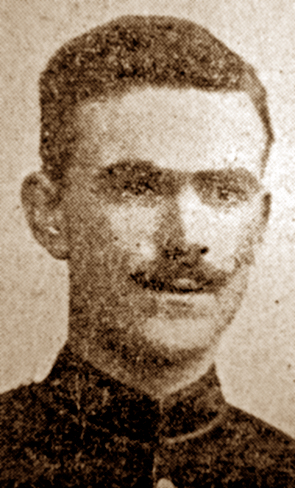
Connects to:
Year of Birth:
Month of Birth:
Day of Birth:
Year of Death:
Month of Death:
Day of Death:
Most Relevant Date:
Source:
Source Date:
Jutland veteran's life in the Navy
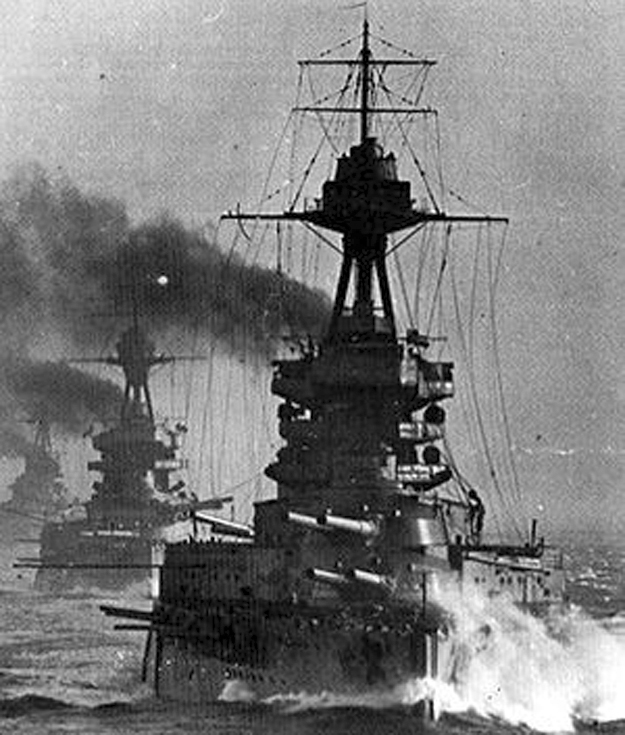
At the age of 44, Luton-born Gunner Seaman Frederick William Nicholls had been in the Royal Navy since a teenager when he served on HMS Benbow (pictured - Wikipedia) during the Battle of Jutland in 1916. He was single and the son of widow Mary Ann Nicholls, of 19 Bolton Road, Luton.
In answer to letters he had received, he wrote to The Luton News to say he had come through the battle with "all four - that means my limbs - and am still smiling, waiting for another smack".
In his letter Seaman Nicholls said he first joined the Navy on June 8th, 1890, as a boy of 16. His first ship was the Boscawen training ship at Portsmouth.
After going through the course there he joined HMS Canada and served two years in the West Indies, after which they were paid off at Portsmouth. He then spent nine months at the Gunnery School at Sheerness [Kent] training to be a Seaman Gunner.
His next ship was HMS Ramillies [Royal Sovereign class battleship] on October 7th, 1893, to relieve HMS Victoria that was sunk in a collision with HMS Camperdown in the Mediterranean. Then followed two years on HMS Empress of India, Channel Fleet. The next ship, his last for foreign service, was HMS Theseus, on which he served from January 3rd, 1899, until May 24th, 1902, when the ship was ordered home from Malta.
His remaining time was served on the destroyer HMS Snapper, finishing in January 1904, when he entered the Royal Fleet Reserve for ten years, completing that in January 1914. When war broke out he immediately volunteered for service and was immediately accepted by the Admiralty and sent to HMS Benbow, the ship on which he served through the Battle of Jutland and on which he was still serving.
His military record shows he served on the Benbow from October 7th, 1914, until October 9th, 1918. He continued his naval career into the 1920s and died in Luton in 1940 at the age of 67.
[The Luton News: Thursday, August 17th, 1916]
- Deejaya's blog
- Log in or register to post comments
Leading Stoker Frederick Neville
Title (Mr/ Mrs/ Capt/ Rev etc):
First name(s):
Surname only:
Leading Stoker Frederick Neville was lost with the sinking of the battlecruiser HMS Queen Mary during the Battle of Jutland on May 31st, 1916. He was 28 years of age.
Born in Luton and a former pupil of Dunstable Road Schools, he had served in the Navy for five years before returning to work at Luton Gas Works for about a year. He then rejoined the Navy about four years before his death.
In 1913 he married Laura Annie (nee Morris) in Portsmouth and they had a little boy born in 1914. At the time of Frederick's death she was living with his sister at 101 Highbury Road, Luton, where she first received an intimation that her husband was missing.
Younger brother Charles Neville, who was in the Cyclist Corps of the E.A.R.E. been invalided home from Gallipoli, wounded and suffering from the effects of dysentery. It had been thought that shrapel had cost him the sight in one eye, but he had recovered and recently been drafted out to Egypt.
Service or Civilian?:
Service Number:
Regiment:
Place of Birth:
Place of Death:
War Memorial Location:
Grave Location:
World War I Address:
Individual Location:
Classifications:
Images:
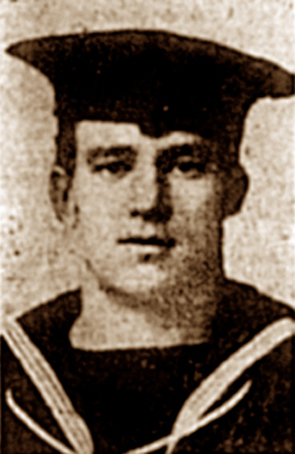
Connects to:
Year of Birth:
Month of Birth:
Day of Birth:
Year of Death:
Month of Death:
Day of Death:
Most Relevant Date:
Source:
Source Date:
Mist - the German Navy's salvation
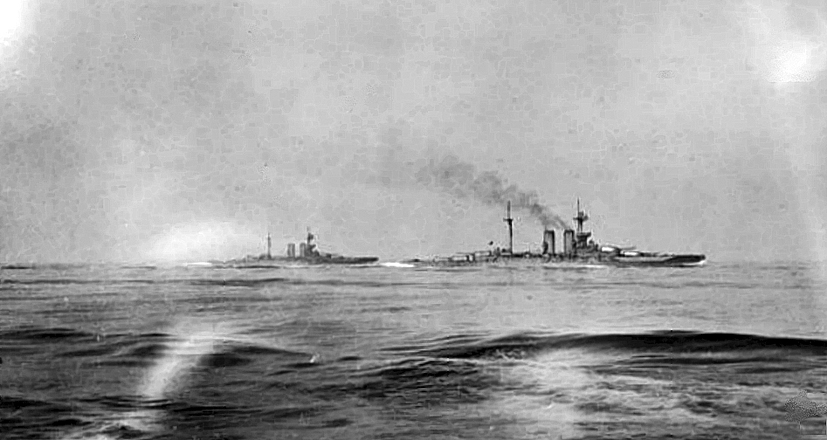
HMS Warspite and Malaya, seen from HMS Valiant (Wikipedia)
Seaman-Gunner F. W. Nicholls, a Luton man on one of the ships in the Grand Fleet, writing on June 5th about the Battle of Jutland, said: "The day we have been waiting for came, but rather late, towards eventide. After waiting nearly two years we got 'the buzz' that our cruisers were in action at 4.10 pm, up against the whole of the German fleet.
"So we went helter-skelter at full speed to their aid and came into them at about six o'clock, and opened fire with our turrets at once. All the Battle Squadron was engaged, on and off, for about three hours, when a mist came over and what would have been a complete wash-out was stopped. "Had the mist cleared for only ten minutes, I can assure you there would not have been a German ship left to tell the lies they are, or were, trying to pump into the papers. I can tell you it was only the providence of God that they got out of gunfire and saw the harbour again, for the mist that came on was their salvation.
"As regards losses, they are awful, but you will see results when all true reports are sent in.
"Well, in the morning at 4.30, we sighted them again, and when they caught sight of the Grand Fleet they nipped like wild cats. Then the curtain fell - more mist.
"We could do not more; our work was done. So we steamed away to see if we could help anybody. Now don't you think we are doing our work? We have got an idea we shall not see them again.
"I can tell you I never saw such a sight in all my experience on the water, and that is a few years. Terrible gun fire, at long range, no back doors."
[The Luton News, June 15th, 1916]
- Deejaya's blog
- Log in or register to post comments
R.N. John McLennan Hine
Title (Mr/ Mrs/ Capt/ Rev etc):
First name(s):
Surname only:
Engineer-Lieut John McLennan Hine was died or was killed as a result on enemy action during the Battle of Jutland on May 31st, 1916, while serving on board the battlecruiser HMS Invincible, which was sunk.
Born in Maryport, Cumberland, in 1872, he and his family had lived in Rothesay Road, Luton, for two or three years prior to 1910. He had married Lydia Emma Booth in Suffolk on May 5th, 1901. They had four children - Alfred, Lydia Margaret, Joan McLennan and Nancy Mary McLennan. Nancy was born in Luton.
A qualified naval engineer, John Hine was chief engineer of the Holme Line of steamships owned by Messrs Hine Bros, of Maryport before coming to Luton. In Luton he first worked for Mr William Looker and later for George Kent's and Balmforth's. He left Luton to take up the appointment of engineering inspector with the Ocean Accident Insurance Co at their Nottingham branch.
Although over military age, he offered his services to the Admiralty on the outbreak of war. When delay took place he accepted the offer of a captaincy in the Sherwood Foresters. In December 1915 he exchanged into the Navy and, after a period of training at Portsmouth, was appointed to the Invincible as engineer-lieutenant.
Service or Civilian?:
Regiment:
Medals Awarded:
Employer:
War time / or Pre War occupation:
Place of Birth:
Place of Death:
War Memorial Location:
Grave Location:
World War I Address:
Classifications:
Year of Birth:
Year of Death:
Month of Death:
Day of Death:
Most Relevant Date:
Source:
Source Date:
Signaller Arthur Olney
Title (Mr/ Mrs/ Capt/ Rev etc):
First name(s):
Surname only:
Signal Boy Arthur Olney, 16, drowned when HMS Queen Mary was sunk in the Battle of Jutland on May 31st, 1916. His body was not found for burial.
Confirmation of his death came in an official intimation from the War Office to his widowed mother Susan at her home, 32 Hibbert Street, Luton.
Educated at Queen Square School, Luton, Arthur Olney served on the Great Northern Railway for 12 months before joining the Navy in which he served for 16 months, 11 months on the Queen Mary.
He had sent a cheery letter home two weeks before his death and was looking forward to coming home on leave in August.
A brother was serving in the 2/5th Bedfordshire Regiment.
Service or Civilian?:
Service Number:
Regiment:
Place of Birth:
Place of Death:
War Memorial Location:
Grave Location:
World War I Address:
Individual Location:
Classifications:
Images:

Connects to:
Year of Birth:
Month of Birth:
Day of Birth:
Year of Death:
Month of Death:
Day of Death:
Most Relevant Date:
Source:
Source Date:
Signaller Frederick George Darby
Title (Mr/ Mrs/ Capt/ Rev etc):
First name(s):
Surname only:
Signal Boy Frederick George Darby was a month short of his 17th birthday when he was drowned when HMS Black Prince was sunk during the Battle of Jutland on May 31st, 1916. His body was not found for burial.
The former Beech Hill pupil had been in the Navy for 18 months at the time of his death. Prior to going to sea he was a straw worker employed by Mrs Kerridge of Bute Street. He served with HMS Powerful and HMS Ganges before joining HMS Black Prince.
His bereaved mother Mary, of 7 Princess Street, Luton, received an official telegram from the Admiralty which read: "Frederick George Darby, signal boy on board HMS Black Prince; to latest information, regret feared lost."
Service or Civilian?:
Service Number:
Regiment:
Employer:
War time / or Pre War occupation:
Place of Birth:
Place of Death:
War Memorial Location:
Grave Location:
World War I Address:
Individual Location:
Classifications:
Images:
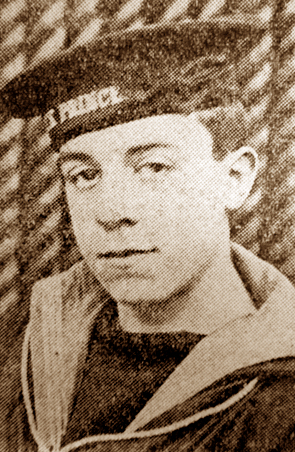
Connects to:
Year of Birth:
Month of Birth:
Day of Birth:
Year of Death:
Month of Death:
Day of Death:
Most Relevant Date:
Source:
Source Date:
Tribute to a Jutland hero who "went west"
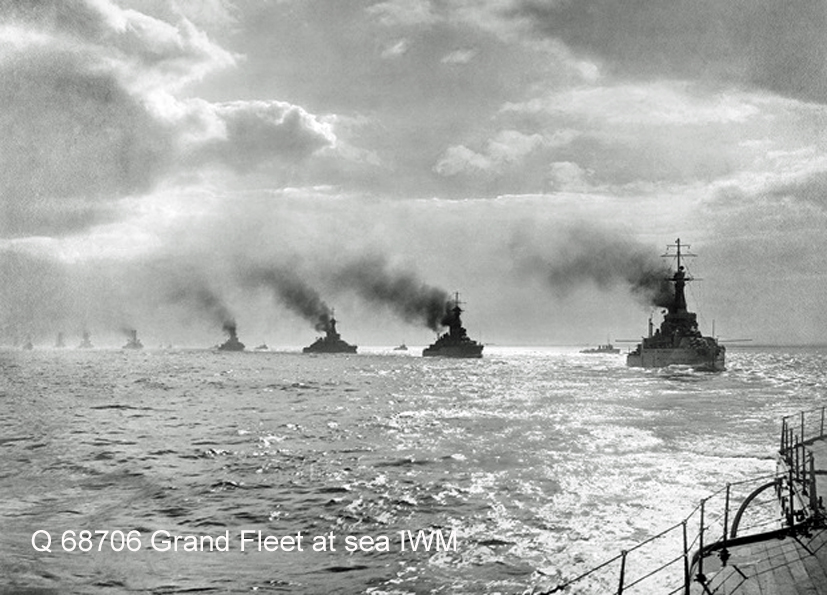
Not many minutes ago I was quick-marching in the rear of a section of our gallant Navy, stepping out briskly towards a harbour where lay some of the ships which the "victorious" German fleet had run away from a week earlier. Sunshine had succeeded a drenching shower, a Marine band played a lively tune, and apparently everything was bright and gay.
So began an article in the Beds & Herts Saturday Telegraph on June 10th, 1916, written by "one of our own" in tribute to an unnamed comrade who "went west" in the Battle of Jutland and was about to be buried somewhere on the North East coast on June 8th.
Half an hour earlier, the article continued, the picture had been very different, and, often as we are told that every picture tells a story, these two contrasting scenes have to be reviewed together to tell this story.
Those men who go down to the sea in ships, and who were stepping out so briskly, had earlier this afternoon set their faces westward. Some of them who had been in the thick of the fray a week earlier only came into port on Tuesday. One of them will never sail again.
While on the grey North Sea he had found that haven whither we all would be. In service language he had "Gone West," and westward he was taken today to a quiet park-like place where flowers bloom round his last resting place, and where the blossom of laburnum is even now dropping on the sods which cover him.
The way to his resting place was by a road which in ordinary times left behind the madding crowds of the town. But today it might have been in the centre of a city. Some were there because the ceremonial offered free entertainment. Others have tragedy always staring them in the face. Their menfolk are on the sea, and from day to day they have a fear that the finger of fate will bear heavily on them. So they were there to mourn with those that mourned, and to pay their tribute of respect to the brave men who had borne the burden of the day, and to the one who would endure the troubles of war no more.
By a queer sport of fate, many of those in the Army party were wearing for the purpose of this ceremonial side-arms which in themselves were ample evidence of the manner in which the Hun had departed from the methods of honourable warfare. The plain service bayonet of the British Army is deadly enough at close quarters, and required a brave man to face it intrepidly. But these Hun weapons are not only double the size of ours, in addition one edge is fashioned into a very brutal saw, and these were the weapons which, having come into our possession, were worn on this occasion in ceremonial for one more brave man whose death lies at German doors.
They made a brave picture, those men in blue. Whether they had gold braid and swords, or just the seaman's blue or the blue and red of the Marines, they were a tangible evidence of the power which keeps England free.
The Army, also, paid its tribute, but whether it was the Artillery, a force which has the fortune to claim precedence next after the Navy or any other branch of the Service, it cannot but have been felt that the tribute which was paid was due as much to the living as the dead.
With drums beating and bands playing the procession wended its solemn, slow way to the flower-surrounded resting place, and many were those who could restrain their tears. The crack of the rifles and the strains of the Last Post, and a storm which in a few seconds drenched the spectators, combined to emphasise the depths of tragedy which had been sounded.
Then, as in a moment of time, the clouds lifted, the sun shone again, the band played a stirring march, and the men in blue set their faces to te sea again. Brisk and alert, they were on the way to another day of reckoning.
And this exemplifies the spirit of the Navy all through. They cannot fight without losing brave comrades, but, much as they may grieve when men with whom they have stood shoulder to shoulder through times of danger are severed from them, they have to face the fight which is yet before them.
So from a graveside almost within sight of the waves they march down to their ships to the strains of a gay tune, not because they are light-hearted, but because to look on the dark side will not strengthen their arms when the day of reckoning does come. Doubtless on "the day" there will be more power to their elbows because of their memories of gallant comrades who are no longer with them to take a hand in the reckoning.
- Deejaya's blog
- Log in or register to post comments
Two Luton boys, 16, lost in Battle of Jutland
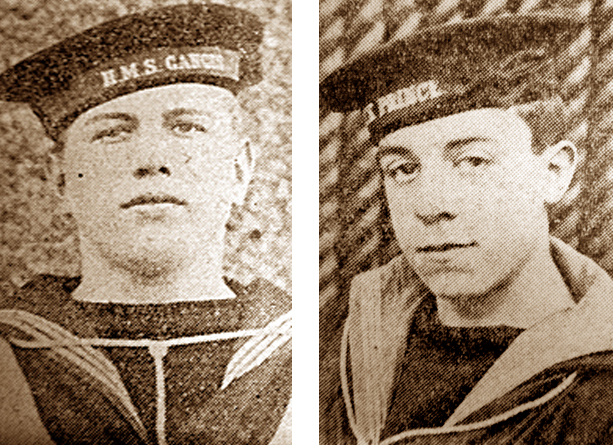
Arthur Olney (pictured above left) and Frederick George Darby (right) were still just 16 years old when they gave their lives while serving on warships during the Battle of Jutland on May 31st, 1916. Both were born in Luton and signal boys on ships that were sunk by the Germans. In the two weeks following the great naval battle, the Luton News and Saturday Telegraph published the following list of Luton men and men with Luton connections who died in or survived the battle.
LOST IN ACTION
Signal Boy J/34280 Frederick George Darby, aged 16, killed or died as a result of enemy action while serving on HMS Black Prince (sunk). Son of Mrs Mary Ann Darby, of 7 Princess Street, Luton. (Chatham Naval Memorial).
Signal Boy J/34158 Arthur Olney, aged 16, killed or died as a result of enemy action while serving on HMS Queen Mary (sunk). Son of Mrs Susan Olney, of 32 Hibbert Street, Luton. (Portsmouth Naval Memorial).
Gunner RMA/12399 Edmund Charles Dexter, Royal Marine Artillery, aged 26, killed or died as a result of enemy action while serving on HMS Invincible (sunk). Son of Edmund E. Dexter, of 5 Warwick Road, Luton, he was married with a wife and three-month old baby living in Portsmouth. (Portsmouth Naval Memorial).
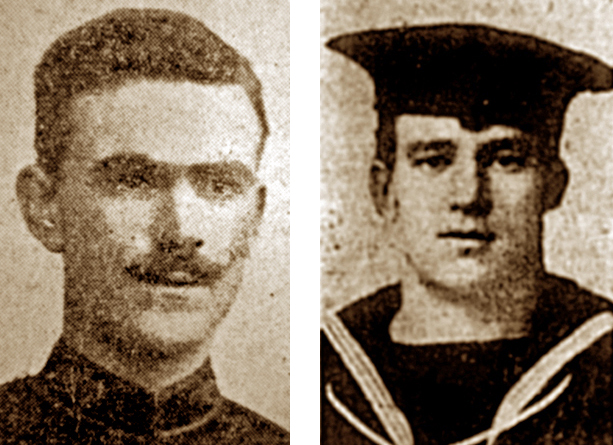
LOST: Edmund Dexter (left) and Fredrick Neville.
Leading Stoker K/22633 Frederick Neville, aged 29, killed or died as a result of enemy action while serving on HMS Queen Mary (sunk). The native of Luton and former pupil of Dunstable Road School had been in the Navy for five years before returning to civilian life for a year, working at Luton Gas Works, and then returning to the Navy four years before the Battle of Jutland. (Portsmouth Naval Memorial).
Engineer-Lieut John McLennan Hine, aged 44, killed in action on HMS Invincible (sunk). He was married with four young children and his family had lived in Rothesay Road, Luton, prior to 1910. (Portsmouth Naval Memorial).
Sub-Lieut Frank Alan Single, aged 20, killed or died as a result of enemy action while serving on HMS Warspite (damaged but returned to port). He was the nephew of Luton hat manufacturer Mr J. C. Kershaw. (Queensferry Cemetery, West Lothian).
MISSING, BELIEVE KILLED
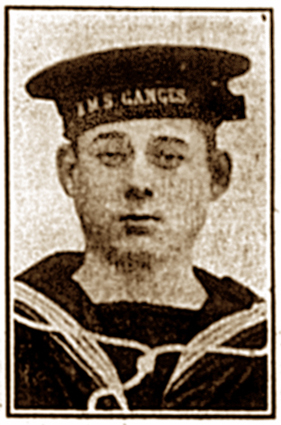 Seaman Henry Shedrick Joseph Hill, (pictured right), 19, son of Mr and Mrs Henry Hill, of 94 Cobden Street, Luton, was reported lost in the Battle of Jutland while serving on HMS Turbulent (sunk). Naval records reveal, however, that he was wounded and taken as a prisoner of war before being repatriated in 1918 and invalided from the service. He married Gertrude Currie in Luton in 1919.
Seaman Henry Shedrick Joseph Hill, (pictured right), 19, son of Mr and Mrs Henry Hill, of 94 Cobden Street, Luton, was reported lost in the Battle of Jutland while serving on HMS Turbulent (sunk). Naval records reveal, however, that he was wounded and taken as a prisoner of war before being repatriated in 1918 and invalided from the service. He married Gertrude Currie in Luton in 1919.
SURVIVORS
Seaman Victor Whittemore, at first reported lost while serving on HMS Queen Mary, confirmed in a letter to his mother at 42 King's Road, Luton, that he had survived the sinking.
First Class Boy Francis James Allen, aged 17, serving as a gun sighter on HMS Warspite, confirmed in a letter to parents Mr and Mrs Samuel Allen, of 59 Warwick Road, Luton, that he was safe. He had joined Warspite at Easter 1915 after training at Shotley Barracks. The former regular attender at All Saints Church, Luton, was home on leave in November 1915 and hoped to be home again shortly.
Seaman Thomas Fensome, youngest son of Mr and Mrs George Fensome, of 93 Hitchin Road, Luton, had served on HMS Warspite, which was damaged in the battle but was credited by its crew with having sent two enemy cruisers and several destroyers to the bottom. The former Diamond Foundry and Hayward Tyler employee was in the ship's magazine below decks during the battle.
Chief Engineer Artificer Frank Holt was another survivor from the Warspite. The former Queen Square and Waller Street schools pupil had been in the Navy for 15 or 16 years and was returning from Australia when war broke out. He was married and a father living in Devonport. His own father, Francis Holt, lived at 53 Adelaide Street, Luton.

SURVIVORS: Left to right - Frank Holt, Victor Whittemore and Francis Allen
- Deejaya's blog
- Log in or register to post comments